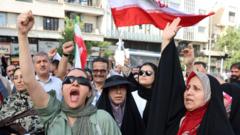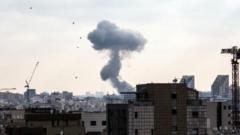**In a groundbreaking operation, the Pentagon executed precision strikes against Iran’s nuclear facilities, raising questions on the implications for nuclear capabilities.**
**Pentagon Launches “Operation Midnight Hammer” Against Iranian Nuclear Sites**

**Pentagon Launches “Operation Midnight Hammer” Against Iranian Nuclear Sites**
**Coordinated military strikes severely damage key facilities in a bold display of U.S. military capability.**
In a remarkable display of military prowess, U.S. Defense officials announced the execution of "Operation Midnight Hammer," a series of covert strikes against Iran's nuclear sites. The strategic military operation, which occurred under extreme secrecy, was directed from the Pentagon and led by Defense Secretary Pete Hegseth alongside Gen. Dan Caine, chairman of the Joint Chiefs of Staff.
The strikes targeted three significant locations: Fordo, Natanz, and Isfahan, with Hegseth asserting that they had “obliterated” the nuclear sites, though the extent of Iran’s remaining nuclear capabilities remains uncertain. General Caine noted that while the final analysis of damage inflicted was pending, initial evaluations confirmed that all three sites "sustained severe damage and destruction."
The air assaults involved B-2 stealth bombers that were launched from Whiteman Air Force Base in Missouri. After taking off secretly Friday night, the bombers embarked on a challenging 7,000-mile trip, executing multiple fuel stops along the way. In a span of just 25 minutes, the bombers struck the heavily fortified facility at Fordo and other critical installations at Natanz, emphasizing the U.S. military's advanced coordination and striking capabilities.
As officials continue to assess the aftermath of the strikes, questions linger regarding the implications for Iran's ongoing nuclear ambitions and the overall security of the region. This unprecedented military maneuver marks a significant escalation in U.S. involvement in Middle Eastern geopolitics.
The strikes targeted three significant locations: Fordo, Natanz, and Isfahan, with Hegseth asserting that they had “obliterated” the nuclear sites, though the extent of Iran’s remaining nuclear capabilities remains uncertain. General Caine noted that while the final analysis of damage inflicted was pending, initial evaluations confirmed that all three sites "sustained severe damage and destruction."
The air assaults involved B-2 stealth bombers that were launched from Whiteman Air Force Base in Missouri. After taking off secretly Friday night, the bombers embarked on a challenging 7,000-mile trip, executing multiple fuel stops along the way. In a span of just 25 minutes, the bombers struck the heavily fortified facility at Fordo and other critical installations at Natanz, emphasizing the U.S. military's advanced coordination and striking capabilities.
As officials continue to assess the aftermath of the strikes, questions linger regarding the implications for Iran's ongoing nuclear ambitions and the overall security of the region. This unprecedented military maneuver marks a significant escalation in U.S. involvement in Middle Eastern geopolitics.























